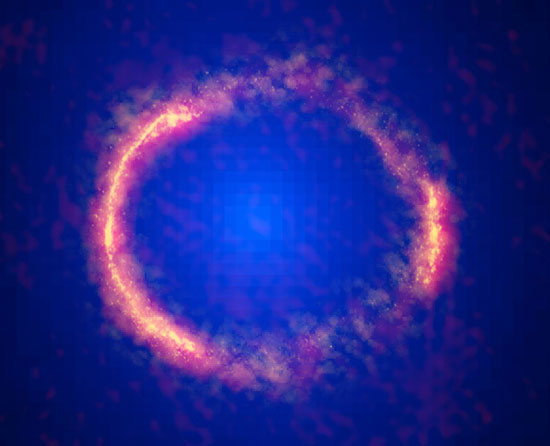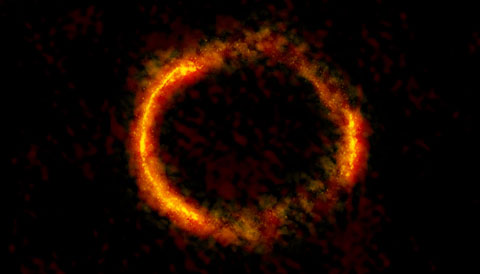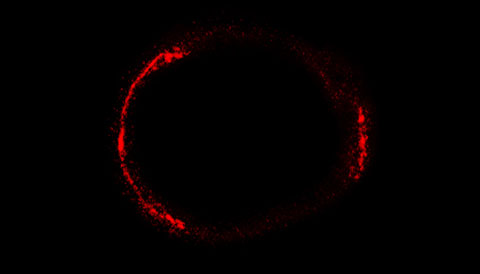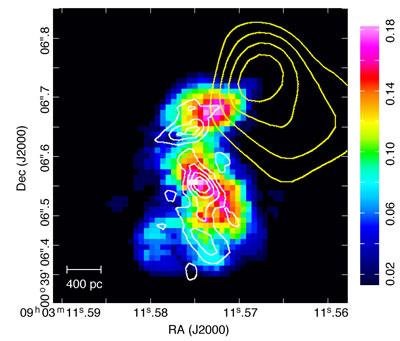A rare type of gravitational lens offers astronomers a close look at a young, dusty galaxy manufacturing hundreds of stars a year.

ALMA (NRAO / ESO / NAOJ); B. Saxton (NRAO / AUI / NSF); Hubble (NASA / ESA); T. Hunter (NRAO)
Within the Hydra constellation, now to the south in northerners’ evening sky, there exists an almost perfect ring of light about 3 arcseconds across. This weirdly symmetric phenomenon is a rare gravitational lens known as an Einstein Ring, the result of a near-perfect alignment between a very distant galaxy, a not-quite-so-distant galaxy, and us.

ALMA (NRAO/ESO/NAOJ) / B. Saxton / NRAO / AUI / NSF
The background galaxy is informally known as SDP.81 (which rolls slightly more easily off the tongue than its formal name, H-ATLAS J090311.6+003906). Its light traveled for 12 billion years to arrive at Earth, but the journey wasn’t uneventful — 8 billion years into its flight, it encountered a massive elliptical galaxy. The galaxy’s gravity acted as a lens, bending the path of the background light to form a ring of emission.
Though these lensed rings are named for Einstein, Einstein himself declared in 1936, “Of course, there is no hope of observing this phenomenon directly.” His pessimism was warranted since he was only considering stars, not galaxies — he reasoned that such perfect alignment would be too rare to glimpse in the real world, and even if visible, he thought the circles’ small angular size was beyond telescopes’ capabilities.

ALMA (NRAO / ESO / NAOJ)
The lensed ring of SDP.81 is small. Your finger held out at arm’s length covers 1°, or 3600 arcseconds. The best ground-based telescopes can make out details separated by 1 arcsecond under good conditions. The Hubble Space Telescope can resolve details 10 times finer, good enough to see the ring itself, but not enough to study it in detail.
Now the Atacama Large Millimeter/submillimeter Array (ALMA) has gone one step further, turning its dishes to SDP.81’s known Einstein ring during testing of its “long baseline” capability. During this time, the antennas’ maximum separation was 15 kilometers (9 miles), offering unprecedented magnifying power. ALMA spied submillimeter-wavelength details in the ring just 23 milliarcseconds (about a millionth of a degree) across.
Combined, the array’s resolving power and nature’s gravitational lens give astronomers a chance to see details spanning just 100 or so light-years — an impressive feat considering the galaxy lives in a universe just 1.8 billion years old. “This is exactly why gravitational lensing is so amazing!” says study coauthor Catherine Vlahakis (ALMA and European Southern Observatory, Chile).
Galaxy Collisions in the Early Universe

Simon Dye & others
As the initial results on SDP.81 were accepted for publication in the Astrophysical Journal, another team led by Simon Dye (Nottingham University, UK) reconstructed the lensed galaxy’s shape based on the distorted light that ALMA and Hubble imaged.
The reconstructed ALMA image shows a rotating disk of dusty gas. Oddly enough, the reconstructed Hubble image, which probes visible light rather than submillimeter-wavelength emission, shows something completely different — a blob of gas offset from the disk.
The disk and blob might be two distant galaxies coincidentally close together along the sky, the authors acknowledge. But just as likely for this crowded time period is that one galaxy has passed through another, leaving behind a dusty disk galaxy that’s popping with stars — about 500 Suns’ worth a year.
These types of merger-induced starburst galaxies were probably common in the early universe. Now with some of the highest-resolution observations to date, astronomers can study their makeup and learn about the earliest phases of galaxy evolution.
 8
8









Comments
Anthony Barreiro
April 14, 2015 at 2:51 pm
Wow, a 15 km baseline. ALMA is amazing.
You must be logged in to post a comment.
April 16, 2015 at 12:07 am
Four Dimensions of Space?
Time is usually taken as the fourth dimension.
But when we see an Einstein Ring image we see four dimensions of space.
Imagine a one-dimensional world (think a strand of spaghetti imbedded in concrete.) How could this world ever have curvature? It is fixed in its space and constrained. But supposing the concrete had a vertical slot running through it. The spaghetti world could now take on curvature in the direction of the slot -- but only because it had that second dimension to "curve into."
Now, imagine a world like a sheet of aluminum foil -- Edwin Abbott's Flatland. It cannot take on curvature because its universe has only two dimensions. But imagine that same flat sheet of aluminum foil wrapping around a sphere taking on the sphere's curvature. It takes a three-dimensional universe to allow a two-dimensional world to take on curvature.
When we look at an Einstein Ring we see curvature of three-dimensional space. But three-space curvature requires a dimension -- a fourth dimenson -- of space.
So, as I see it, there are (at least) four dimensions of space.
You must be logged in to post a comment.
Lindsay
April 17, 2015 at 9:22 pm
Is gravity 'bending' time creating the fourth dimension?
You must be logged in to post a comment.
April 20, 2015 at 10:55 pm
An interesting question --- but I'm not sure that time can be "bent".
According to Einstein the experience of time is relative to both velocity and the intensity
of the local gravitational field.
My idea in the original post is that "curvature" in N-space requires N+1 dimensions to accommodate the curvature. So when we see an Einstein ring we are seeing curvature of 3-space and this requires a fourth dimension of space.
You must be logged in to post a comment.
Lindsay
April 17, 2015 at 9:27 pm
This is only tangentially related. In theory, is it possible to locate the epicenter of the Big Bang (for example, lying in one of the constellations in the sky), and would it be a volume of space totally devoid of galaxies because no galaxy had formed yet?
You must be logged in to post a comment.
Peter Wilson
April 18, 2015 at 10:37 am
No such epicenter has been found; it is therefore assumed that the universe is infinite: the "center" is both everywhere and nowhere.
You must be logged in to post a comment.
Lindsay
April 18, 2015 at 9:33 pm
Thanks Peter! Do you have a good reference (not terribly mathematical) on this? Is your statement based on the 'fact' that "The Big Bang is a singularity extending through all space at a single instant."? I found this statement at the 2012 blog: http://www.astro.ucla.edu/~wright/cosmology_faq.html#ct2 This UCLA blog says that one kind of measurement says the universe is at least 70 billion light years in diameter. I don't understand how the universe could be infinite in spatial dimension and yet have a non-infinite life span.
You must be logged in to post a comment.
Peter Wilson
April 19, 2015 at 6:43 pm
You're welcome.
Actually, the "epicenter" cannot be seen. Picture an expanding circle: a 1-dimensional string. It is finite, and has a center, but an ant confined to the single dimension of the string cannot see said center. Same with an expanding 2-dimensional surface, i.e. a sphere: an ant confined to its surface cannot see the center. Same with our expanding 3-dimensional space: it can be finite, like the circle and sphere, and have a center, but its center cannot be “seen” by those within it! The “center” is a mathematical construct, like imaginary numbers, and not a “place” that can be observed. The real argument for infinite space is more convoluted than above; try Wicki.
Like God, there is evidence-for infinite space, but not proof-of. Your reference says the universe is at least 70 bly across, but infinity is “way bigger” than 70 bly.
You must be logged in to post a comment.
You must be logged in to post a comment.